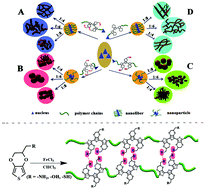Self-assembly of pendant functional groups grafted PEDOT as paracetamol detection material†
Abstract
In this paper, pendant functional group grafted EDOTs, such as EDOTCH2NH2, EDOTCH2OH and EDOTCH2SH, were selected as monomers for the preparation of their respective polymers via a common chemical oxidative polymerization method in the absence of CTAB by varying the [monomer]/[oxidant] ratios. The self-assembly mechanism of the polymers was systematically studied by discussing the hydrogen bonding effect, acidity and electron-donating ability, as well as the chain initiation and chain growth of the chemically oxidated polymerized monomers. These functional group grafted PEDOTs were applied to the electrochemical determination of paracetamol (PAR) to further investigate the effect of the pendant functional groups (–SH, −OH, −NH2) on the electrochemical sensing behaviour of the polymers. The results indicated that the hydrogen bonding effect of the pendant functional groups was vital to the self-assembly of the polymer chains, and the PEDOTs with −OH and −SH groups had a tendency to self-assemble into a spherical structure, while the PEDOT with an −NH2 group exhibited a fibrous structure. The electrochemical response of PEDOTs with functional groups was better than that that of PEDOT alone, and the highest electrochemical response was observed in PEDOT with an –SH group ([monomer]/[oxidant] = 1 : 8).



 Please wait while we load your content...
Please wait while we load your content...